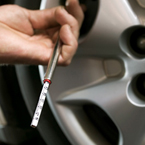 When it comes to driving in the winter, some drivers assume that the only thing they need to worry about is keeping warm. However, the hazardous winter driving conditions present a number of different challenges, with traction being one of the most serious. Slushy, icy, wet roads present a serious hazard for drivers, and it is important to do everything you can to ensure that your car stays on the road safely. Your tire pressure is an important part of the puzzle.
When it comes to driving in the winter, some drivers assume that the only thing they need to worry about is keeping warm. However, the hazardous winter driving conditions present a number of different challenges, with traction being one of the most serious. Slushy, icy, wet roads present a serious hazard for drivers, and it is important to do everything you can to ensure that your car stays on the road safely. Your tire pressure is an important part of the puzzle.
Checking your tire pressure is one of the easiest auto maintenance tasks that you can carry out. Purchase a tire pressure gauge for a few dollars and you can check the tires at home. If your readings don’t match the manufacturer’s guidelines, visit a gas station or visit us at DCH Toyota of Oxnard to make the adjustments. Maintaining the right pressure helps ensure that your car handles well and that the tires wear evenly and ultimately last longer. Keeping the right tire pressure in winter becomes a little more complicated, however.
The colder weather causes the air temperature in your tires to drop. The drop in temperature means that the air inside the tire contracts, lowering the air pressure. If you start driving, the air in the tires warms up again, but lowers as soon as you stop. This makes it harder to keep the tire pressure within the recommended range. If you take the pressure before you start driving you will get a different result to one that you take after you have just driven a long way.
What does this mean? Well, if you suffer relative extremes in temperature during the winter (cold nights and warmer, sunny days), then the time of day that you adjust your tire pressure could have different results. Set in the afternoon, when it is warmer, and you may find that the pressure is not suitable when you leave for work in the morning.
There are three things that you can do to help combat this:
- Take the outside temperature into account. If you are adjusting pressure when it is warmer, then you need to account for the decrease in temperature overnight. Increase the tire pressure during a particularly cold spell.
- Check the pressure more often. Try to check the pressure every few days, particularly during extremes of temperature.
- Use the manufacturer’s recommended pressure. This is the pressure when the tire is cold.
Keeping your tire pressure correct during the winter could save you money and keep you safe. Talk to your dealer if you have any questions.



